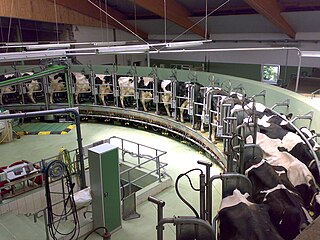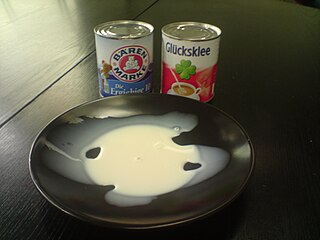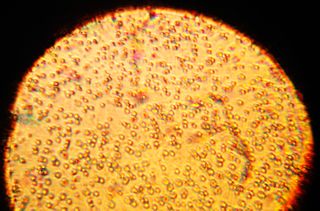Related Research Articles

Milk is a white liquid food produced by the mammary glands of mammals. It is the primary source of nutrition for young mammals before they are able to digest solid food. Milk contains many nutrients, including calcium and protein, as well as lactose and saturated fat. Immune factors and immune-modulating components in milk contribute to milk immunity. Early-lactation milk, which is called colostrum, contains antibodies and immune-modulating components that strengthen the immune system against many diseases. The US CDC agency recommends that children over the age of 12 months should have two servings of dairy (milk) products a day, and more than six billion people worldwide consume milk and milk products.

A kitten is a juvenile cat. After being born, kittens display primary altriciality and are fully dependent on their mothers for survival. They normally do not open their eyes for seven to ten days. After about two weeks, kittens develop quickly and begin to explore the world outside their nest. After a further three to four weeks, they begin to eat solid food and grow baby teeth. Domestic kittens are highly social animals and usually enjoy human companionship.

Dairy farming is a class of agriculture for the long-term production of milk, which is processed for the eventual sale of a dairy product. Dairy farming has a history that goes back to the early Neolithic era, around the seventh millennium BC, in many regions of Europe and Africa. Before the 20th century, milking was done by hand on small farms. Beginning in the early 20th century, milking was done in large scale dairy farms with innovations including rotary parlors, the milking pipeline, and automatic milking systems that were commercially developed in the early 1990s.

Colostrum is the first form of milk produced by the mammary glands of humans and other mammals immediately following delivery of the newborn. It may be called beestings, the traditional word from Old English dialects, when referring to the first milk of a cow or other animals. Most species will begin to generate colostrum just prior to giving birth. Colostrum has an especially high amount of bioactive compounds compared to mature milk to give the newborn the best possible start to life. Specifically, colostrum contains antibodies to protect the newborn against disease and infection, and immune and growth factors and other bioactives that help to activate a newborn's immune system, jumpstart gut function, and seed a healthy gut microbiome in the first few days of life. The bioactives found in colostrum are essential for a newborn's health, growth and vitality. Colostrum strengthens a baby's immune system and is filled with white blood cells to protect it from infection.

Evaporated milk, known in some countries as "unsweetened condensed milk", is a shelf-stable canned cow’s milk product for which approximately 60% of the water has been removed from fresh milk. It differs from sweetened condensed milk, which contains added sugar and requires less processing to preserve, as the added sugar inhibits bacterial growth. The production process involves the evaporation of 60% of the water from the milk, followed by homogenization, canning and heat sterilization.

Breast milk or mother's milk is milk produced by the mammary glands in the breast of female humans. Breast milk is the primary source of nutrition for newborn infants, comprising fats, proteins, carbohydrates, and a varying composition of minerals and vitamins. Breast milk also contains substances that help protect an infant against infection and inflammation, such as symbiotic bacteria and other microorganisms and immunoglobulin A, whilst also contributing to the healthy development of the infant's immune system and gut microbiome.

Breast engorgement occurs in the mammary glands due to expansion and pressure exerted by the synthesis and storage of breast milk. It is also a main factor in altering the ability of the infant to latch-on. Engorgement changes the shape and curvature of the nipple region by making the breast inflexible, flat, hard, and swollen. The nipples on an engorged breast are flat or inverted. Sometimes it may lead to striae on nipples, mainly a preceding symptom of septation mastitis.

Transfer factors are essentially small immune messenger molecules that are produced by all higher organisms. Transfer factors were originally described as immune molecules that are derived from blood or spleen cells that cause antigen-specific cell-mediated immunity, primarily delayed hypersensitivity and the production of lymphokines, as well as binding to the antigens themselves. They have a molecular weight of approximately 5000 daltons and are composed entirely of amino acids. Transfer factors were discovered by Henry Sherwood Lawrence in 1954.
Bee sting is the sting from a bee.

Breast shells are hollow, lightweight plastic disks worn inside the brassiere to help correct flat or inverted nipples either in preparation for or during breastfeeding. Also known as milk cups, breast cups, breast shields, or Woolwich shields, they can also be used to ease sensitive nipples or collect milk when the baby has not finished the teat. Breast shells function by applying gentle but firm pressure to the region surrounding the nipple to stretch underlying adhesions and draw out the nipple. Nipple shields may be confused with breast shells, but shields are intended for use during the act of breastfeeding, whereas breast shells are worn in preparation for or after breastfeeding.

Breastfeeding, also known as nursing, is the process where breast milk is fed to a child. Breast milk may be from the breast, or may be pumped and fed to the infant. The World Health Organization (WHO) recommend that breastfeeding begin within the first hour of a baby's birth and continue as the baby wants. Health organizations, including the WHO, recommend breastfeeding exclusively for six months. This means that no other foods or drinks, other than vitamin D, are typically given. The WHO recommends exclusive breastfeeding for the first 6 months of life, followed by continued breastfeeding with appropriate complementary foods for up to 2 years and beyond. Of the 135 million babies born every year, only 42% are breastfed within the first hour of life, only 38% of mothers practice exclusive breastfeeding during the first six months, and 58% of mothers continue breastfeeding up to the age of two years and beyond.

Lactation describes the secretion of milk from the mammary glands and the period of time that a mother lactates to feed her young. The process naturally occurs with all sexually mature female mammals, although it may predate mammals. The process of feeding milk in all female creatures is called nursing, and in humans it is also called breastfeeding. Newborn infants often produce some milk from their own breast tissue, known colloquially as witch's milk.

Ábrystir is a type of colostrum pudding consumed in Iceland. It is made from cow's or sheep's milk and has a rich and thick texture similar to that of crème caramel. Ábrystir can be eaten hot, lukewarm, or cold, and it is common to add sugar or cinnamon to the pudding to enhance its flavor.
Caprine arthritis encephalitis virus (CAEV) is a retrovirus which infects goats and cross-reacts immunologically with HIV, due to being from the same family of viruses. CAEV cannot be transmitted to humans, including through the consumption of milk from an infected goat. There is no evidence that CAEV can cure HIV in humans.

Kalvdans is a classical Scandinavian dessert. It is made from unpasteurized colostrum milk, the first milk produced by a cow after giving birth.
Infant feeding is the practice of feeding infants. Breast milk provides the best nutrition when compared to infant formula. Infants are usually introduced to solid foods at around four to six months of age.

Pig milk is typically consumed by piglets. It is similar in composition to cow's milk, though higher in fat and more watery. Pig milk is seldom obtained for human uses and is not considered to be a viable agricultural product. Several attempts have been made to produce pig milk cheese, some of which have been successful.

Sibyl Taite Widdows was a British scientist and member of the chemistry department at the London School of Medicine for Women for 40 years.

Human milk immunity is the protection provided to the immune system of an infant via the biologically active components in human milk. Human milk was previously thought to only provide passive immunity primarily through Secretory IgA, but advances in technology have led to the identification of various immune-modulating components. Human milk constituents provide nutrition and protect the immunologically naive infant as well as regulate the infant's own immune development and growth.

Libba', Laba is a type of Yemeni cheese. It is mostly eaten in rural areas of Yemen and Somalia as well. The libba is not sold as a product or in restaurants.
References
- ↑ Lopez, Rachel (20 April 2018). "Through the milky way". Hindustan Times. Retrieved 15 July 2018.
- ↑ Uchil, Shraddha (8 October 2016). "These are the best desserts of Mumbai's 5 iconic eateries". Mid Day. Retrieved 30 July 2018.